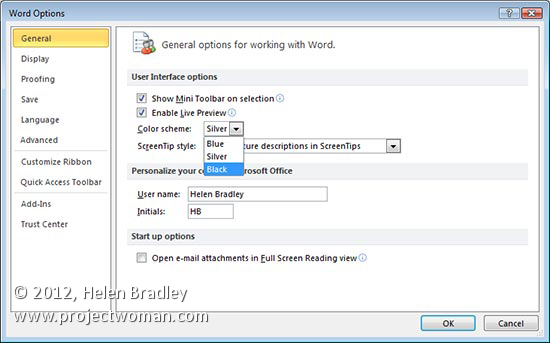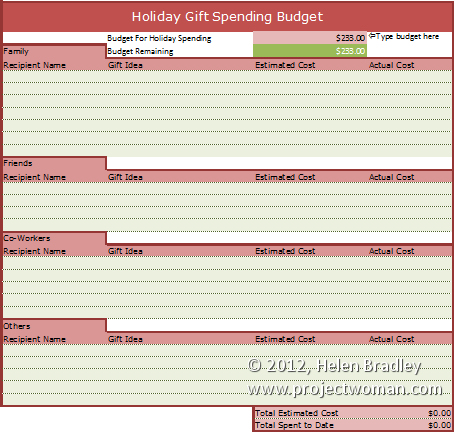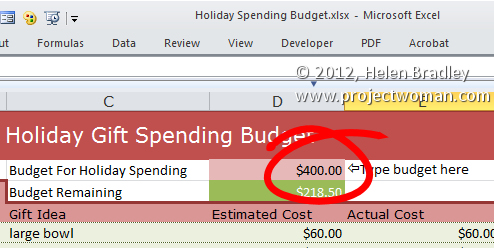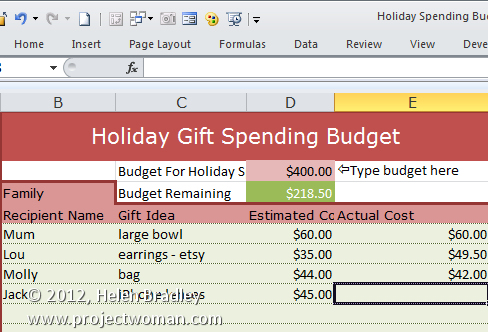Tuesday, November 13th, 2012
Trevor’s Quick Word Tip – Move in Dialog Boxes
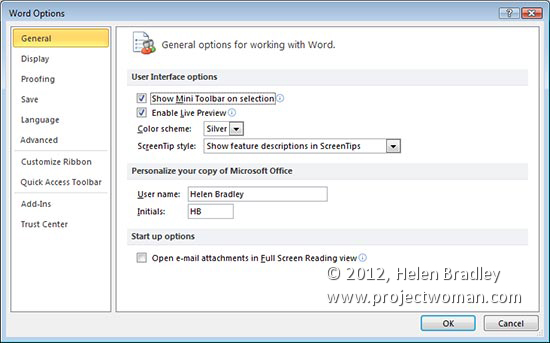
In any Windows program, Office included you can move through dialog boxes quickly without using your mouse if you press the Tab key on your keyboard. Tab moves you from one selectable item to the next. To move in reverse press Shift + Tab. If you press Ctrl + Tab you can move to the next tab in a tabbed dialog and press Ctrl + Shift + Tab to go back one tab.
Labels: dialog box, how to, Microsoft Office, navigate dialog, tip, trevor office, trevor payne, Word
Tuesday, November 6th, 2012
Trevor’s Quick Excel Tip – Select Everything

To select an entire row or column in an Excel worksheet, click the column letter or the row number. To select multiple columns or multiple rows click and drag over the column letters or row numbers to select. To select the entire worksheet, click the empty box at the intersection of the Rows and Columns in the top left of the worksheet.
Labels: cells, Excel, help, how to, Microsoft, select, spreadsheet, tip, trevor office, trevor payne
Wednesday, October 31st, 2012
Word 2013 – What’s new
Learn what is new in Word 2013 and how you can put it to work in your day. Features include new Design tab, start screen, Layout Options, PDF editing, Table border painting, styles and sampler, Read Mode options, Present Online, Save to skydrive, insert images and video from the web.
Transcript:
Hello, I’m Helen Bradley. Welcome to this video tutorial. Today we’re going to look at what’s new in the new Word 2013. This is the new start screen that you’ll see when you start Word 2013. And it’s similar to that in Excel and PowerPoint and Publisher. You’ll see the recent documents that you’ve had open down the side of the screen here, and you’ll be given the option to open other documents for example from SkyDrive or your local computer. There are templates here and these are current so at the moment it’s sort of October so we’re seeing Thanksgiving and Halloween templates. They will change with the seasons. If there is a template that you like you can click on it and you can pin it to your start screen. You can also click to have a look at it in more detail. If there are multiple images you can look through it here. If you want to use it click Create, otherwise just close it down, and you can go and have a look at another template. You can search online for templates and there are some suggested searches here. If you have your own templates you can click Personal and view the templates that you’ve created for yourself. Up here in the top corner are details of the account that you’re currently logged into. So this tells me I’m logged in to this particular SkyDrive account. Let’s open a document and we’ll start working inside the new 2013.
Here I have a document open inside the new Word 2013. You’ll see that the screen is very clean. It’s got that sort of metro style interface that is typical of the new Office 2013 suite. Everything is very flat and your documents sort of take center stage. So let’s have a look at a couple of the new features. The first one is the new read mode. I’m going to View and then Read mode because a lot of people actually use Word as a reader. So I’m just going to set this back to the layout that you will see by default. This is this sort of two column layout which allows you to work through the document and read it and particularly appropriate for using on a tablet. You can change this to the regular page layout if you want to by choosing Paper Layout. There are paper colors that you can choose. We’re obviously using sepia at the moment. And you can set it to the default which is two columns, narrow or wide as you choose.
There are some other features here. If you right click a word you can click Define and it will be defined on the screen for you. I don’t have a word that’s actually going to be definable to show you that, but it works just fine. The other thing in this read mode is that you can look at things more closely. For example we might look at this chart and double click it. And it will now open over the top of the document so that we can look at it in more detail. And that happens as well with smart art. Now this read mode is not looking at the document the way it would be presented so things may overlap if they’re complex. The important thing about this read mode is that it’s for reading the document and not sort of previewing it the way it’s actually going to appear when it’s printed.
I’m just going to escape out of here to go back to the regular Word. Now one of the other changes to Word is in the review area so I’m going to open a different document. I have one here that has track changes in it. The track changes feature has been overhauled a little bit. Let’s go into review and I’m just going to show the new mode which is simple markup. In simple markup we’re going to see the document as it would be if all the changes were incorporated. So that’s text that is inserted is inserted and text that has been marked for deletion is deleted. And we can switch between these two modes either by choosing simple markup or all markup here on the tab, or we can click these lines. These are lines indicating that there are changes here, but we’re seeing it in simple mode at the moment. So we’re not seeing the changes. We’re just being warned that there are changes. Click again and now we can see what the changes are.
There are some changes too to comment. So for example if somebody adds a comment to a document, if you want to reply to that comment you can click this Reply button that allows you to now reply to that comment. The changes here are quite significant because in the past if you wanted to reply to a comment all you could do was add another comment. So conversations could become quite long and complex as they sort of scrolled down the page. Here now all the comments or all the conversation about a particular point can be isolated inside a single comment. And I’m just going to delete that comment. Let’s just get rid of it in its entirety and let’s go back to viewing this document in the new simple markup.
Now I’m going to get rid of all the changes in this document. I’m going to accept everything because I want to show you some of the new design features in the new Design tab. The new Design tab has put together some of the features that were really difficult to find in earlier versions of Word, in particular the sort of document formatting styles. Now you can see what the document formatting styles are. And if you like one you can click on it to apply it to your document. And there are lots of different styles here to choose from. This is the one that we were using previously, but they’re easy to find and to use. If you see one that you like, for example we might like this sort of gray look, we could change the color scheme that’s applied to it. So we could make it blue for example. There’s also the ability to choose different font combinations for our document if we like the look of it but prefer a different combination of fonts for example.
Now if we create a look that we like and we want to use it every time we open Word then we can set this as default. This is a new option on the Design tab. If we click this, this is now going to be the default look for all our documents in future. So this new Design tab has lots of features on it that make things more accessible than they were. Of course if we want to format individual elements on this page we’d back to the Home tab and selecting styles. But these styles are linked to the design or the document format that we’re using here from the Design tab.
Still in this document I’m just going to change its rotation back to normal and we’re going to have a look at the new layout options that we have for this. One of them is this layout options icon here which makes it more accessible to find the text wrapping options. In the past these were really quite difficult for people to find. And now they’ve been attached to the image itself. You can also opt to move the image with the text or fix its position on the page. If you click See More you’ll get the more traditional layout dialog. There are also alignment guides so watch as I move this image around the page. It becomes aligned or we can see when it is aligned to various objects on the page because we get this green alignment guide appearing. So we can see when it’s aligned with paragraphs, with margins of the page, perhaps the edge of the page itself. So this allows you to align things up more easily than you’ve been able to do in the past. Now still in this document we’re going to have a look at the new navigation pane. I’m choosing View and then Navigation Pane. This document has been set up using styles. So because it’s been set up using styles I can navigate the document by selecting the headings in this navigation pane. It just makes it easier to move around and particularly a long document. In addition, there are these new collapse icons. Again, because this document has been formatted using heading styles these collapse and expand icons appear and I can click on them to collapse the document down to just the heading. So imagine this in a really long document. If you had really large headings that had lots of text underneath then you could collapse your document so that you only work on the headings that you’re interested in working on at the time and then you can expand the other headings as you go through it. Now this is a feature that used to be available in outline mode but it’s been brought into print layout. So it’s accessible to any document that you create using heading styles, not only the ability to collapse and expand paragraphs but also this slightly smarter and more useful navigation pane.
Now as well as collapsing parts of the document you can now collapse the ribbon. So you can click here to collapse the Ribbon and it collapses to just the headings. And then you can click to open it. You can pin it or unpin it depending on what you want it to appear like. I’m going to pin it because I like to see the ribbon particularly on large screens.
Before we start looking at tables let’s just go to headers and footers. I’m going to choose Insert and then I’m going to just insert a plain old header into this document. One of the changes here to the header option is that there is access to document info. You can get access to the author, file name, pathname and document title from the Header tab and that’s new in this version of Word. So let’s just close out of there and let’s switch to a document that has a table in it. Here we have a document that has a table in it, and with the table selected we now have options for formatting that table. From the Design tab you’ll see that there are additional table styles here. And these are theme aware so they’re going to look like the theme itself. So I’ve just applied one of them here. Now I can go ahead and format this table a little bit better if I want to. I’m thinking that the text would be better white. So let’s just go and get some white text, and let’s make it a bit bolder.
Now there is a new feature with the design of this table in the border. So we’re going to the table, let’s just grab the table. I’m going to the Design tab and here are our new border styles. This allows us to bypass the old border option that was available inside Word and to paint borders on. Now I can click here for border styles, and I’ll get borders that are theme aware. So these are borders that look like the theme. So I’ll just select one, but I might make a slight change to it. I think I’ll add a slightly wider border. So I’m choosing the color I want from the styles, but I’m making it a bit wider. Now I’m going to click on the border painter and I’m going to start Painting this border onto my table. And wherever I click and paint it’s going to be painted on. So this allows me to paint borders on where I want them to appear and to remove them where I don’t want them. For example, I could just set a border to none and they would be removed. Now let’s say that I make a mistake down here and I paint this border on by mistake. I want to go back to the regular border. Then all I need to do is from the border styles option here is choose my border sampler. I can sample a border. It’s now attached to the border painter. So having sampled it, I can now paint it back onto the table. So this gives me a lot more flexibility in working with tables than I’ve ever had particularly with borders and tables because that’s really been a nightmare issue for a lot of users.
Now the other thing that I can do in tables that I haven’t been able to do easily in the past is to add a row or a column. All I need do is to position my cursor just where I want the row or column to be inserted and I get this new indicator. And I can click to insert a row. I’m just going to undo that. But let’s go and see that the same thing appears between columns so we could add an extra column to the document. Let’s just undo that. We could also add one at this edge if we want to. So there are some new features inside Word not only new table styles but the ability to paint on borders, to sample borders and to access border styles.
The new features in Word 2013 extend to images and video. If you click the Insert tab you get access to online pictures. So you can view images that are in the office.com clipart collection. You can search Bing or you can go and search your own SkyDrive account. So let’s just type cupcake here. You can see that our cupcake image came from there, but you can add additional images by just clicking on them to insert them into your document. The same thing happens with video content. You can click Online Video and access online video. The benefit of these insert video and online picture options is that you can insert content direct from the web without needing to download it and save it to your computer first.
Let’s have a look at some of the screens that are available here. The open screen gives you access to recent documents, and if you click Computer you’ll see access to your recently open folders. And you can pin folders here as well as pin documents here. You can also get access to your SkyDrive account. One of the new features is in this share Option because you can now present online. If you click this you can go into a present online feature that is presented through the Office presentation service which is a new service. And this is similar to presenting a PowerPoint presentation online. Your presentation or your Word document is uploaded and you’re given a link that you can then share with others and they can watch as you present the document to them. You also have the ability to publish blog posts and invite people also to share your document. This would be done via a SkyDrive location. Here are the account options. Here you can see what account you’re currently logged into. You can also add services. For example we could add a LinkedIn or Twitter service here. We’re already connected to Facebook and SkyDrive, and you can see your update options.
The other feature that I want to talk about is the ability to open and edit PDFs. So I have the open screen available here, and there is a PDF that I just downloaded. So I’m just going to click it to open it. Now you’ve never been able to do this before inside Word and that is to open a PDF for editing. Now the application is not perfect. In fact it’s far from perfect, particularly with complex documents like this one that actually has images and pieces in it. But if we go to the select pane here we’re able to actually locate the picture and the elements that are part of this document so I can actually find these shapes. And I’m just deleting them. So I’m getting rid of these shapes that made the image and now I have something more attune to the original PDF and I could make changes to it. I would probably need to reformat this table as tables aren’t particularly friendly. But you do get access to the internal contents of a PDF file which you couldn’t in the past.
So there’s a roundup of the features that are new in Word 2013. I’m Helen Bradley. Thank you for joining me for this video. Please subscribe to my YouTube channel so that you’re advised of new videos. You can also find more blog posts and information on my website at projectwoman.com.
Labels: 13, design, features, Microsoft, new, Office, PDF, table, Word
Wednesday, October 24th, 2012
PowerPoint 2013 – What’s new and cool
PowerPoint just got a whole lot cooler, so come check out what’s new. I’ll walk you through many of PowerPoint 2013’s features, including the new start screen and account screens, how saving is new, using the new task panes, charting options, and discovering theme variants.
Transcript:
Hello, I’m Helen Bradley. Welcome to this video tutorial. Today we’re going to be looking at the new PowerPoint 2013 and asking what’s new and cool for PowerPoint users. There is a lot to like about the new PowerPoint 2013. And we’re going to have a look at some of the features of it here in this video.
The first thing is the Start screen. This opens as soon as you open PowerPoint 2013. And there’s a lot here for new users. You can actually turn the screen off. But I think most people are going to opt to turn it on. The default is to start with a new presentation with a default theme, but you can see here that we’ve got recent files that we’ve opened in PowerPoint so they’re all available to us. We could go online and search for templates and themes online. And there are some suggested searches here. We can also click here to open other presentations that we might have stored on SkyDrive or on our local computer or SharePoint. And up here is the current account. So when You open PowerPoint 2013 or any of the new Office 2013 applications you’re going to be logged into your SkyDrive account, and this is access to it. And here we could switch accounts if we wanted to. These are just for testers so I think that they’re probably going to go in the final production.
But let’s have a look and see what would happen if we selected one of these templates. So I’m just going to click this one to open it. And you can see here that there’s some variants in this theme. We’re having a look right now at the More Images so we can see what this layout is going to look like if we select this particular one. And there’s this title layout, and this is what the chart would look like, and then smart art graphics, and this is a photo layout. And then there are different variants, different color combinations that we could use in this particular theme. Now what they’ve done in PowerPoint 2013 is that they’ve removed some of the color options that we had previously and sort of scaled them down to a more manageable group. So this particular design has four color options and you choose one of them and go with it rather than having to select from a set of color schemes that are probably twenty or thirty of them.
So I’m really liking this sort of red one so let’s click Create. And we’re now all ready to start our PowerPoint presentation. None of this is going to be unusual for PowerPoint users. A little bit has changed with the interface here. You can see that it’s got a metro style look to it so everything is a lot flatter. There’s no dimension in the screen, no shading. The buttons have sort of all gone to the back and really what we’re doing is focusing a little bit more on the content of our presentation.
Let’s go to Backstage View before we come back here though and see what’s there. I’ll click File to go to Backstage View. Now some of these options have changed. There’s Save and Save as. If we go to Save as you’ll see that by default we’re now saving to SkyDrive so this is the SkyDrive account that I was already logged into. Details are up here, and it’s opting to save it to SkyDrive by default. If I want to I can save it to my own computer so I can click Computer and this gives me access to my own folder structure. I can also add a place. So I could add things like a SharePoint location or a different SkyDrive account. Print is pretty standard. There’s not much changes here but Share has some options. You can invite people to share your document on your SkyDrive account. You can email it. You can present it online or publish your slides here. Export here we’ve got our PDF, XPS document support. Here’s the video option. Here’s packaging it for a CD, creating handouts and changing our file type. Down here are the standard options. This is general options for working inside PowerPoint and there’s not much changed here. Let’s go back here however to this Account area. And this is where you manage your accounts. So at the moment you can see that I’ve got a connected service with my Facebook account, my SkyDrive account, Twitter. I can also add LinkedIn if I wanted to. I could add Flickr. There’s the ability to add SharePoint or another SkyDrive account, lots of options here. And I imagine that over time we might see even more appearing here. This is also showing me where I am with my product. I can get updates and get information about whether the updates are installed, whether there are any, and it’s just telling me which version of Microsoft PowerPoint I’m using. So there’s our Backstage View. There’s our Start screen.
So let’s go back now and have a look and see what’s different inside the PowerPoint interface itself. The ribbon is pretty standard from the older versions of the ribbon. The difference is that the Design tab is split in two now with the themes and the variants. So here we have the various themes that we can use. We’re using this one here, but you can see that what we’re using this variant of it. This is another one of the built in themes for PowerPoint 2013, and here are the variants so we could make it blue or pink, whatever we want to do here.
The Developer tab is now visible by default so that’s a big change for people who want access to macros. I’ve got some additional things open here, and it’s picked up my old handy Tools tab which is one that I added to my PowerPoint 2010 and it’s been brought forward into 2011. So too has the add-in Visual Bee. But these are things that I’ve added in myself. They’re not actually in the default PowerPoint install. There is a new button here on the toolbar. It’s the Touch Mode button, and you can enable it if you’re on a touch screen. With that enabled, if I just tap it what happens is that the buttons become a little bit further apart and everything is a little bigger for work on a touch screen. Click it again and everything shrinks down just a little bit.
Let’s have a look at adding a chart so I’m just going to go back to the Home screen. And we’ll do a new slide with a chart so I’m going to choose a title and a content slide. And let’s just add a chart to our Presentation and close this down. These settings here are new, and these are in Excel as well. So these give you the ability to add chart elements or remove them. For example if we don’t want a legend we could just disable the legend here. We could also for example disable the chart title if we planned to add the chart title in as the slide title. There’s access here to styles and color options. And you can see that we could change the colors but we’ve got a smaller subset of colors this time. And they’re more true to the theme itself. So we’ve been given smaller numbers of options but probably more relevant options if you could think of it that way. And then here we’ve got other settings. We can change the values and the names. So there’s options here for working with our chart.
Let’s go again and let’s add another new slide. This time I want to add an image. So I get a choice of selecting pictures from my own computer or online pictures. Online pictures allows me to select images from Office.com clipart. I can search them using Bing or I could go and get them from my SkyDrive account. It’s also possible for me to get them from my Flickr account. So let’s just go and get an image right now. Let’s go and get a coffee image. Okay, let’s grab this one here. And I’m going to insert it so I’m just clicking it and tap Insert. And now we’ve got our image inserted on our slide.
Now if we wanted to make changes to this image we would typically go to the Picture Tools Format tab. But watch what happens when I right click the image here and choose Format Picture. What we get is this new format picture pane here. It’s a task pane. And in it are all the things that we can use to format our pictures. So let’s go ahead and let’s add a reflection to this picture, just add a very simple reflection to it.
Okay, let’s go now and add another slide and this time I’m going to add a small art graphic. So let’s just add a default smart art graphic. But look what’s happened to our pane. Now we’re seeing Format Shape options because these are the options that we can use with this smart art graphic. If we go back to this slide here and click on the picture the pane is still there. It stays in place if we want it to, but it changes to show us the kind of options that we have for the object that we’re working with. And I think users are going to really like this because you don’t have dialogue sitting over the top of your slides. This is all tucked away on the side and you can leave it open as you work. And it’s just giving you much quicker access to things. You can see we haven’t moved away from the Home tab and yet we’ve got most of the smart art tools available that allow us to format the smart art as we work.
Now another handy tool we’ve got is the eyedropper tool. So I’m just going back to this image and I am going to click on the image and go to Picture Tools Format tab. And I’m going to select Picture Border. So instead of actually choosing one of these theme colors what I can do is use the new eyedropper tool. What the eyedropper tool does is to allow me to select a color from the image itself. So I can just mouse over an area of the image and select that as the color of my picture border for example. So it’s now my selected color so I can now add a border to the image that is a color that I’ve selected from the image itself. Now you may be missing the color options that you used to have inside PowerPoint, but we still have access to them. We just have access to them in a limited way.
So let’s say that we like this general layout, but we’d really like it to be a different color combination. In this case we’ll go to the View option and we’ll go to Slide Master View. In Slide Master View we can control the slide master that controls the look and feel of out presentation. And you can see here that the All Theme Color options are back again. So for example if we wanted to use a theme color for example medium we could do that. And here’s our medium color scheme that’s now been applied to the presentation. I’ll close Master View and let’s go back into the Design View.
We’ve still got the four options that came with this slide presentation, but we also have our own custom option that’s a Slide Master that we can use. Now if we like this color scheme in preference to the other variants we can save it as we always could, just drop down this theme option and save the current theme. So you do get the customization options of being able to change colors, but you get it where they really should have been all along which is in the Slide Master because you really want it to be thematically strong and you want this color scheme to be applied throughout the entire presentation. Now some of the other options that are available inside PowerPoint 2013 is the Video options so you can select Online Video or Video on your PC. There are a few more options in working with video content. You’ll find things in the Slide Show menu.
When you go to rehearse a slide show or set up a slide show you’ll have different options in terms of viewing presenter view so you can actually see presenter view if you want to. So let’s just do that. And let’s send the slide show to the monitor and the primary monitor which is not the one I’m using right now, and let’s do Presenter View. And let’s just view the slide show. So here’s our Presenter View. You can see that we can see which slide we’re on and we can navigate through the slides. In fact this is my title slide and this is the next one up. And there’s two and three. We can also use a See All Slides option where you can see the slides themselves. You can press Escape here and you’re just going back into Presenter View, not ruining the presentation which is actually running on my second monitor right now. You’ve got the ability to zoom into the slide show so you can click on here and zoom it up full screen. And there are the standard laser pointers so you can use a laser pointer on your screen and you can see other slide show options here.
So there’s plenty to like about this new PowerPoint 2013. I think you’ll like it a lot. If you haven’t already done so why not go and download the customer preview and install it and have a play around with it. I’m Helen Bradley. Thank you for joining me for this presentation. You can find more of my videos here on my YouTube channel. I encourage you to subscribe to the video channel as we’re releasing at least two new videos every week. And also follow me at projectwoman.com where you’ll find tips and tricks for all the Office applications as well as much, much more. If you liked this video please go ahead and like it and I’m always happy to hear your comments.
Labels: 2013, art, backstage, chart, image, insert, Office, PowerPoint, screen, skydrive, smart, Start, view
Tuesday, October 23rd, 2012
Trevor’s Quick Word Tip – Setting your Preferences
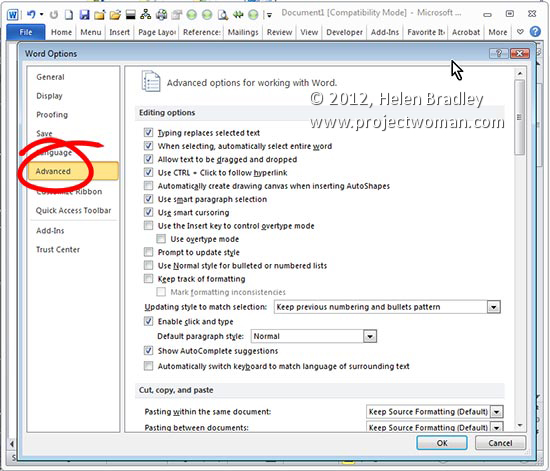
It’s generally a great idea to go through Word and set it up for your own personal working style. Head to the preference area by clicking File > Options (Office button > Word Options in Word 2007) and click Advanced. Here you can set preferences for Editing, Printing, Display and so on to make Word work the way you want it to.
Labels: how to, Microsoft, preferences, set up, tip, trevor office, trevor payne, Word
Thursday, October 18th, 2012
Holiday Gift Budget Worksheet
Don’t blow the budget this holiday season!
Our holiday gift buying budget worksheet will help you avoid a Yule tide spending blow out.
In the interests of helping you better control your spending this Holiday Season we have a free spreadsheet download in the form of a Holiday Gift Spending Budget.
Grab this version for Excel 2007/2010/2013 – gotta love the formatting available in those versions.
If you’re stuck in the land of Excel 2003 and earlier (or want to use it in Zoho, Google Docs, OpenOffice.org or anything else that can read Excel files), then grab this plainer but still fully functional version.
The worksheets are protected against wiping out key formulas and entering data in the wrong cells but there’s no password there so you can easily unprotect if you desire.
To use this worksheet, download the one for your Excel version, open it in Excel (or another compatible program), and then, in cell D2 type the amount you can afford to spend.
Then add entries for family, friends, co-workers and others – determine what you will get them and how much you are budgeting to spend. At this stage you can see if you are on track or already over budget.
As you buy presents, fill in the actual amount spent and in cell D3 you will see what you still have to spend of your budget amount or if have spent all you have allowed for.
Labels: budget, christmas, download, Excel, free, gift, holiday, present, spending, spreadsheet, worksheet, xls, xlsx
Tuesday, October 16th, 2012
Trevor’s Quick Word Tip – Remove unwanted formatting
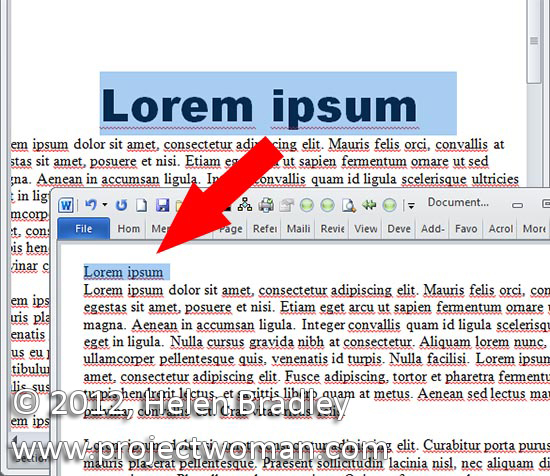
If you are having second thoughts about the look of your document you can remove the formatting. Select the text that you want to strip of its formatting and and press Ctrl + Space Bar to remove its formatting. If you press Ctrl + Shift + N you’ll apply the default Normal style to the selected text.
Labels: formatting, Microsoft, remove formatting, style, trevor office, trevor payne, Word
Tuesday, October 9th, 2012
Trevor’s Quick Excel Tip – Date and Time

To enter the current date and time into a worksheet cell type =NOW() to display both the date and time based on the regional options that are set for your copy of Windows. If you want the date and not the time, type =TODAY(). These formulas update themselves every time Excel is opened, the worksheet is recalculated or if it is printed. If you need to enter the current date or time so it is fixed and so it won’t change, press press Ctrl + ; for the date or Ctrl + Shift + ; for the time.
Labels: date and time, enter date, Excel, functions, how to, Microsoft, tip, trevor office, trevor payne
Tuesday, October 2nd, 2012
Trevor’s Quick Word Tip – Disappearing Ribbon
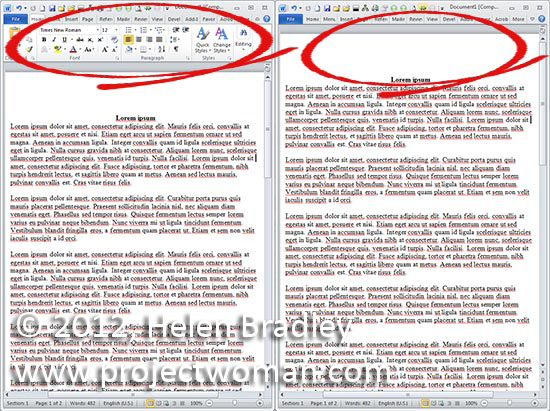
Does the Ribbon in Microsoft Word make your workspace feel cluttered, distracting you from the work at hand? If so, double click any of the tabs to hide the Ribbon or press Ctrl + F1. When you want the Ribbon back repeat these steps to recover the Ribbon
Labels: disappearing, how to, Microsoft, Ribbon, tip, trevor office, trevor payne, Word
Tuesday, September 25th, 2012
Trevor’s Quick Word Tip – Paste Preferences
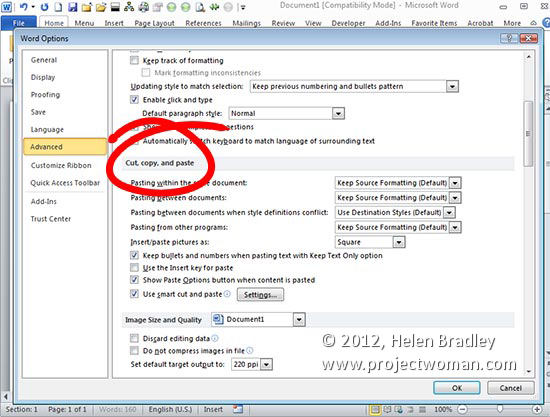
Setting up your pasting preferences in Microsoft Word can speed up your workflow when you’re working from another resource. You can do this by clicking File > Options (Office button > Word Options in Word 2007) and then click Advanced. You’ll find what you’re looking for under the Cut, Copy and Paste section. Set your default paste preferences to those that best fit your needs and click OK.
Labels: copy and paste, Microsoft, Paste preference, preferences, tip, trevor office, trevor payne, Word, Word 2010
Tuesday, September 18th, 2012
Trevor’s Quick Excel Tip – Navigate cells

Move around the cells in your workbook without touching your mouse using the Up and Down and Left and Right Arrow keys. To jump to the edge of the current block of data press Ctrl + the appropriate arrow key – so to move to the last row press Ctrl + Down Arrow.
Labels: 2010, Excel, how to, microsoft excel, navigate cells, tip, trevor office, trevor payne
Monday, July 30th, 2012
Create an Outlook task from an Outlook email
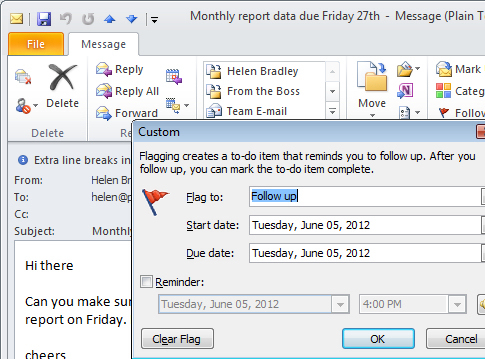 When you’re reading an email message in Outlook, often you will realize that you need to create a task in relation to that email’s contents. To do this, with the email open on the screen, click the Message tab and click the Follow up icon.
When you’re reading an email message in Outlook, often you will realize that you need to create a task in relation to that email’s contents. To do this, with the email open on the screen, click the Message tab and click the Follow up icon.
From the list select a task date for managing that email task. If you click Custom, you can select an appropriate flag for the email such as Follow Up, Forward or Reply and set the Start Date and Due Date for completing the task. Enable the Reminder checkbox and you can set a reminder time for the task. Click Ok to enter the email as a task.
Labels: e-mail, email, Outlook, Outlook 2010, task
Wednesday, July 25th, 2012
Configure PowerPoint 2010 Animations
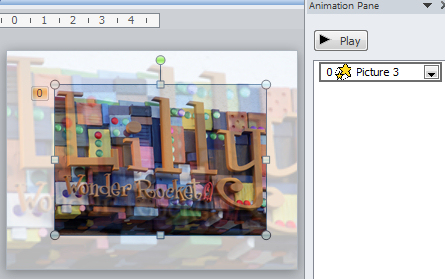
In earlier versions of PowerPoint you could select the size for a Grow/Shrink animation. In PowerPoint 2010 it seems these features are more limited – that’s not the case but to make them more useful you need to know how the animations can be configured.
On a slide with a full size image on it, click the Animations tab and select the Grow/Shrink animation – it is an Emphasis effect.
If you select Effect Options you will see that you can select Both so the animation grows in both directions. Now select Larger or Huge. In most cases, Larger will be sufficient but notice that it appears as if you can only choose Larger or Huge as bigger sizes and that there is nothing in between these two settings. This is where you can get misled.
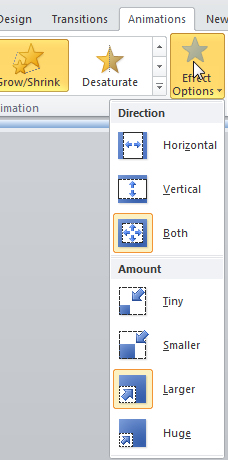
Click the Animation Pane icon to display the Animation pane. Right click the entry for your image in the Animation Pane and choose Effect options. See that the Size is set to 150 % but you can set it to any value of your choice using the Custom option.
For example, set it to 75%. Here too you can add Smooth Start and Smooth End to the effect and a Bounce to the end of it.
In most cases, you’ll want your animation to start immediately the slide appears so click the Timing tab, set the Start option to After Previous. Set the Duration value to your choice of speed and click Ok.
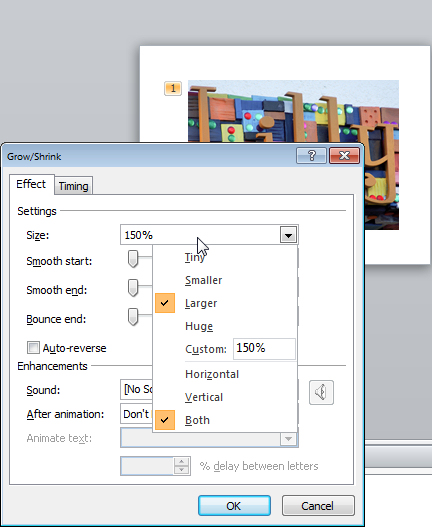
It’s best to test your animations using the slideshow preview rather than the animation pane.
Labels: animate, animation, animation pane, Duration, emphasis, entrance, exit, grow/shrink, Helen Bradley, PowerPoint 2010, Start, Timing
Friday, July 20th, 2012
5 Cool Excel 2010 tips and tricks
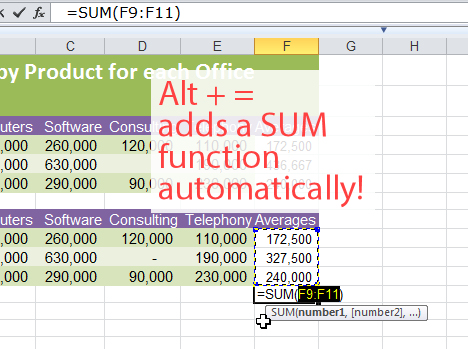
Here are five cool tips, tricks and keystrokes to help your day go faster in Excel:
Display cell formulas and not results
If you want to see the cell in your worksheet display formulas rather than the results of those formulas then you can do it one of two ways.
Use the keyboard shortcut Ctrl + ~ to toggle formula display on and off
You can also use Formulas > Show Formulas
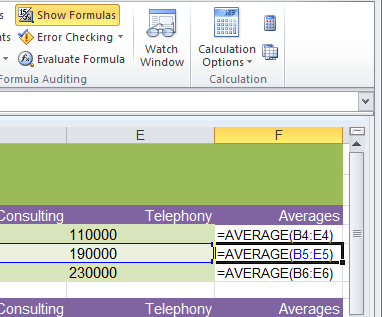
Start a new line
When you need to add a line break to a cell to start a new line of text press Alt + Enter in the cell. If you just want to wrap a long piece of text in a cell right click the cell and choose Format > Alignment tab > Wrap Text.
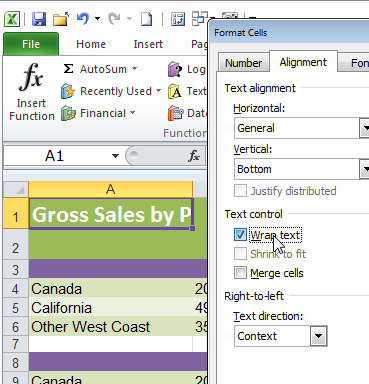
Copy the contents of the cell above
To copy the contents of the cell above into the current cell press Control + ‘.
Moving around super fast and super smart
To move from one sheet in a workbook to the next (or in reverse), press Control + PgDn and Control + PgUp. To move to the next open workbook press Control + Tab or Control + Shift + Tab.
Super quick mouse free SUM formula
Skip taking the mouse to your Ribbon to add a SUM function and do it with a simple keystroke instead. Type Alt + = and Excel adds the SUM function automatically to the current cell. Doesn’t get much easier than that!
Labels: cool, copy formula, Excel 2007, Excel 2010, excell, format, Helen Bradley, keystrokes, line break, new line, shortcut key, show formulas, sum function, techniques, tips, tricks, Wrap text


